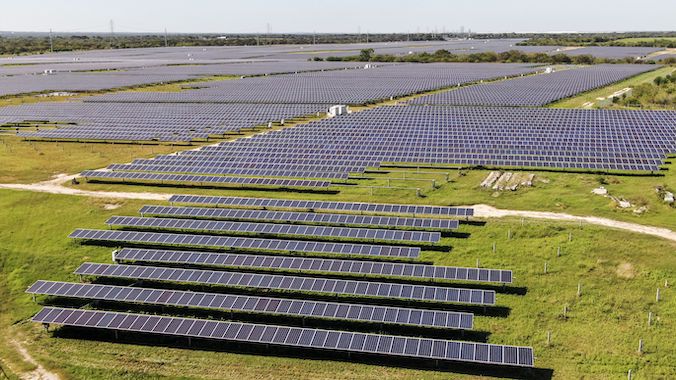Solar Eclipse Makes U.S. Energy Transition Progress and Limitations Clear
Photo by TANNEN MAURY/EPA-EFE/Shutterstock
As the full solar eclipse moves across the country this afternoon, the electricity output from a whole lot of solar panels will drop. As much as 30 gigawatts of power will dim out, requiring utilities to ramp up other sources of electricity in order to compensate. This is, seen from one angle, a very good thing.
According to the U.S. Energy Information Administration, “the effect of the 2017 solar eclipse on the power system was minor.” That’s because seven years ago, we just didn’t have that much solar power on the grid — since then, the country has added almost 100 gigawatts of utility-scale and smaller solar power, of a total electricity capacity of about 1,300 gigawatts. At the end of last year, solar power represented about eight percent of the grid, up from just one percent in 2017; that’s a lot of panels looking up at a moon-covered sun.
Grid operators have accounted for the problem. For example, the country’s biggest such operator, PJM Interconnection, has plans to manage a loss of 4.8 gigawatts of solar generation; it wouldn’t be hard either way, most likely, but the issue is helped by mild temperatures across much of the country, meaning not much need for heating or cooling during the eclipse.
Texas faces an even bigger challenge, where its grid operator ERCOT says solar generation will drop from more than 10 gigawatts to only 1.3 gigawatts during the event. ERCOT also says they don’t expect much of an issue, though.
Again, this is a good semi-problem to have. But it also shows the lengths still ahead of us: the U.S. Department of Energy projects that a net-zero grid in 2050 will need to get 45% of our electricity from the sun. And then there’s the batteries: in 2017, there were only 0.6 gigawatts of battery storage installed on the grid, a technology capable of filling gaps in generation thanks to interruptions like eclipses or, say, night time. According to the EIA, that’s only up to 15.4 gigawatts today in total, a sluggish rate of deployment that has been hindered by high costs, among other things.
To get to a point where a zero-carbon grid covered in wind turbines and solar panels would not need much or any help from natural gas power plants — which is where most of the help will come from today when the evil spirits blot out the sun — that 15.4 gigawatts of energy storage will need to leap all the way to 930 gigawatts, according to the National Renewable Energy Laboratory.
The eclipse is being billed as a “test” of the increasing penetration of renewable energy. This tends to ignore all the grid failures that have little to do with solar or wind power, but it also sort of misses the main points about the underlying need for that ongoing transition: we’re doing pretty well from some angles, and also, we need to do a whole lot better.